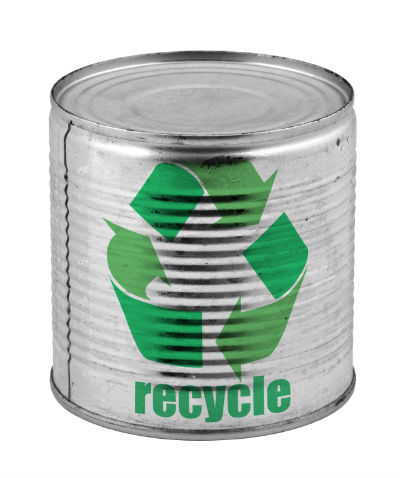
Metal is a desirable material — the U.S. alone uses
100 million steel cans and twice that amount of aluminum cans every day. Fortunately, common types of metals such as tin cans, copper, aluminum and steel can be recycled. Although each metal goes through a slightly different reclaiming process, the end result offsets mining waste.
Tin and steel
For every ton of tin cans, 95% is made from steel and the remaining 5% is made from tin. Originally, these cans were referred to as “tinned cans” since there is a thin layer of tin on the outside that prevents the can from rusting. Before this metal can be recycled, it has to be detinned, but even before this, consumers like you have to get the tin cans to a recycling center.
When
preparing tin cans for collection, it’s more efficient for the recycling center if you wash the can, remove its top and bottom and then flatten it as much as possible. The curbside collector will be able to store more cans in the truck if the cans are compact.
After pick-up, the cans are either taken to a detinning plant or sold through a dealer. At the plant, the cans are bathed in a caustic chemical solution that strips the exterior layer of tin. Then an electrolysis bath relies on electricity to attract the tin to a plate. Once all of the tin is separated from the aluminum and collected on the plate, it’s melted and turned into a metal cast or ingot.
The steel part of the can be separated from other recyclables via magnets, and it gets shipped off to a
steel mill to be melted down by a furnace. The liquid steel is poured into sheet-like molds and can then be turned into new products such as cars, cans, boats, etc.
Aluminum
Beverage cans and other aluminum products are repurposed in a similar way to steel. However, the aluminum
must be shredded prior to melting. Through either a recycler or scrap metal dealer, this type of metal goes to a producer or smelter to be ground into small chips. Then it is melted down by a furnace and turned into ingots. Finally, the large masses of metal are taken to a manufacturing plant to be rolled into sheets, and at this point, the aluminum can be reused as new cans or car castings.
Copper
Copper is often used for wiring, so it’s important that it is of a certain quality and standard, which is why it has to be
inspected and graded prior to recycling. Number 1 copper is melted and can achieve a higher quality through
fire refining. Next, the hot copper is deoxidized and turned into billets or ingots. Any loose scrap copper is stored away for future processing.
With so many metal products and parts, it’s imperative that we continue to reuse and recycle these precious materials. Through the recycling process, 95% less energy is consumed in comparison to making products from virgin metal, and that is too large of a percentage to ignore.
 Metal is a desirable material — the U.S. alone uses 100 million steel cans and twice that amount of aluminum cans every day. Fortunately, common types of metals such as tin cans, copper, aluminum and steel can be recycled. Although each metal goes through a slightly different reclaiming process, the end result offsets mining waste.
Metal is a desirable material — the U.S. alone uses 100 million steel cans and twice that amount of aluminum cans every day. Fortunately, common types of metals such as tin cans, copper, aluminum and steel can be recycled. Although each metal goes through a slightly different reclaiming process, the end result offsets mining waste.
 Metal is a desirable material — the U.S. alone uses 100 million steel cans and twice that amount of aluminum cans every day. Fortunately, common types of metals such as tin cans, copper, aluminum and steel can be recycled. Although each metal goes through a slightly different reclaiming process, the end result offsets mining waste.
Metal is a desirable material — the U.S. alone uses 100 million steel cans and twice that amount of aluminum cans every day. Fortunately, common types of metals such as tin cans, copper, aluminum and steel can be recycled. Although each metal goes through a slightly different reclaiming process, the end result offsets mining waste.